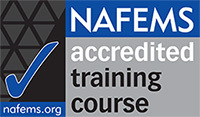| Duration: | 1.5 day |
| Delivery: | Web Based Training
Onsite Classroom |
| Language: | English |
| Level: | Mid-level |
| Availability: | Worldwide |
| Tutor(s): | Gino Duffett |
Request Full Details
Recognise next level design methodologies utilizing simulation results to explore the whole design space.
- How do I create an optimization process?
- Can I just press a button to optimize my product?
- How do I optimize a manufacturing or other process?
- What is the difference between genetic and evolution optimization algorithms?
- What optimization tools can help me if I have a simulation that takes a very long to run?
This course answers these questions by providing an extensive overview of design and optimization methods that enable engineers to enhance their designs by using optimization strategies. These could be single- or multi-objective, including many different disciplines using a range of variables and including restrictions and decision making. Generic, evolution and other optimization algorithms are discussed, advice is provided, and problematic issues are highlighted to guide engineers in creating successful, efficient optimization strategies.
Some people consider that optimization is part of an engineer’s primary job. In general, no one will accept a project if they think it can be improved in any way. However, there are many variables to deal with considering the time and cost restraints, not to mention the number of technical restrictions.
Computers and software came to the rescue so that we now have process software that cleverly controls other software to run simulations and automatically improve our original design. However, doing this efficiently is not a standard or straightforward process. The course thus provides information on tools that help us determine trends and make decisions leading us to an optimal design.
Interaction is encouraged throughout the course. Questions and class participation are encouraged, as these are key aspects in making this a unique and positive experience for each attendee.
Who should attend
Engineers and designers who are interested in using design optimization methodologies to explore the whole design space leading to improved and optimized designs for products and processes.
Course Program
This course combines information, examples, case-studies and time for open discussion of the concepts presented:
- Design cycles
- Optimization within a design cycle
- Simulation Process Integration
- Optimization
- Basics
- Single- and Multi-objective optimization
- Basic methodologies
- Topology Optimization
- Concepts, methods, and examples
- Design of Experiments (DoE)
- Parameter Optimization
- Concepts and guidance
- Methods (gradient, GA, evolution, others)
- Decision making tools
- Response Surface/Meta-model methods
- Methods and algorithms
- Real-life/Experimental information
- Robust design methodologies
- Examples in many sectors are distributed throughout the course
Interested?
Get in touch to discuss your next steps with our experienced training team. We can work closely with you to understand your specific requirements, cater for your specific industry sector or analysis type, and produce a truly personalised training solution for your organisation.
All NAFEMS training courses are entirely code independent, meaning they are suitable for users of any software package.
Courses are available to both members and non-members of NAFEMS, although member organisations will enjoy a significant discount on all fees.
NAFEMS course tutors enjoy a world-class reputation in the engineering analysis community, and with decades of experience between them, will deliver tangible benefits to you, your analysis team, and your wider organisation.



